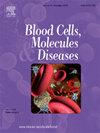Red blood cell pyruvate kinase properties in Townes and Berkeley sickle cell disease mouse models – Of mice and men
IF 1.7
4区 医学
Q3 HEMATOLOGY
引用次数: 0
Abstract
Pyruvate kinase (PK), a key ATP-generating enzyme in glycolysis, is a target for novel sickle cell disease (SCD) therapies. Enhancing PK activity lowers 2,3-diphosphyglycerate (2,3-DPG), increases adenosine triphosphate (ATP), and may prevent red blood cell (RBC) sickling. Townes and Berkeley SCD mouse models are commonly used for the development of novel drugs for SCD, but differ from humans in 2,3-DPG and ATP levels, which could be related to underlying differences in PK properties. This study revealed important distinctions with humans (SCD vs healthy controls), such as similar PK/hexokinase (HK) ratios between sickling and non-sickling mouse models and significantly lower PK thermostability in mice. We additionally investigated the effect of a novel RBC PK activator, compound A, on PK properties and sickling tendency in these mice in order to assess SCD mouse model suitability. Results showed that a single dose of compound A led to an increased affinity of PK for phosphoenolpyruvate, a significant increase in PK/HK ratio and a decrease of 2,3-DPG levels. Together, these results offer detailed characterization in the PK properties of two commonly used SCD mouse models, and provide insight into the mode of action of PK activator therapy in SCD mice models.

汤斯和伯克利镰状细胞病小鼠模型中的红细胞丙酮酸激酶特性-小鼠和男性
丙酮酸激酶(PK)是糖酵解过程中关键的atp生成酶,是新型镰状细胞病(SCD)治疗的靶点。增强PK活性降低2,3-二磷酸甘油酸(2,3- dpg),增加三磷酸腺苷(ATP),并可能防止红细胞(RBC)镰状细胞。Townes和Berkeley SCD小鼠模型通常用于开发用于SCD的新药,但在2,3- dpg和ATP水平上与人类不同,这可能与PK特性的潜在差异有关。该研究揭示了与人类(SCD与健康对照)的重要区别,例如镰状病和非镰状病小鼠模型之间的PK/己糖激酶(HK)比率相似,并且小鼠的PK热稳定性显著降低。我们还研究了一种新的红细胞PK激活剂化合物a对这些小鼠PK特性和镰状倾向的影响,以评估SCD小鼠模型的适用性。结果表明,单剂量化合物a可提高PK对磷酸烯醇丙酮酸酯的亲和力,显著提高PK/HK比值,降低2,3- dpg水平。总之,这些结果提供了两种常用的SCD小鼠模型的PK特性的详细特征,并提供了PK激活剂治疗在SCD小鼠模型中的作用模式的见解。
本文章由计算机程序翻译,如有差异,请以英文原文为准。
求助全文
约1分钟内获得全文
求助全文
来源期刊
CiteScore
4.90
自引率
0.00%
发文量
42
审稿时长
14 days
期刊介绍:
Blood Cells, Molecules & Diseases emphasizes not only blood cells, but also covers the molecular basis of hematologic disease and studies of the diseases themselves. This is an invaluable resource to all those interested in the study of hematology, cell biology, immunology, and human genetics.

 求助内容:
求助内容: 应助结果提醒方式:
应助结果提醒方式:


